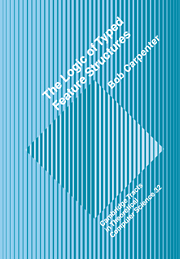 The Logic of Typed Feature Structures
The Logic of Typed Feature Structures Published online by Cambridge University Press: 12 October 2009
In this chapter we consider the addition of variables ranging over feature structures to our description language. It turns out that the addition of variables does not increase the representational power of the description language in terms of the feature structures which it can distinguish. Of course, this should not be surprising given the description theorem, which tells us that every feature structure can be picked out as the most general satisfier of some description. On the other hand, we can replace path equations and inequations in favor of variables and equations and inequations between variables if desirable. We prove a theorem to this effect in the latter part of this chapter. The reason that we consider variables now is that they have shown up in various guises in the feature structure literature, and are actually useful when considering applications such as definite clause programming languages based on feature structures. Our treatment of variables most closely follows that of Smolka (1988, 1989), who treats variables as part of the language for describing feature structures. Aït-Kaci (1984, 1986) also used variable-like objects, which he called tags. Due to the fact that he did not have a description language, Aït-Kaci had to consider variables to be part of the feature structures themselves, and then factor the class of feature structures with respect to alphabetic variance to recover the desired informational structure. We have informally introduced tags in our attribute value matrix diagrams, but did not consider them to be part of the feature structures themselves.
We assume that we have a countably infinite collection Var of variables.
To save this book to your Kindle, first ensure [email protected] is added to your Approved Personal Document E-mail List under your Personal Document Settings on the Manage Your Content and Devices page of your Amazon account. Then enter the ‘name’ part of your Kindle email address below. Find out more about saving to your Kindle.
Note you can select to save to either the @free.kindle.com or @kindle.com variations. ‘@free.kindle.com’ emails are free but can only be saved to your device when it is connected to wi-fi. ‘@kindle.com’ emails can be delivered even when you are not connected to wi-fi, but note that service fees apply.
Find out more about the Kindle Personal Document Service.
To save content items to your account, please confirm that you agree to abide by our usage policies. If this is the first time you use this feature, you will be asked to authorise Cambridge Core to connect with your account. Find out more about saving content to Dropbox.
To save content items to your account, please confirm that you agree to abide by our usage policies. If this is the first time you use this feature, you will be asked to authorise Cambridge Core to connect with your account. Find out more about saving content to Google Drive.